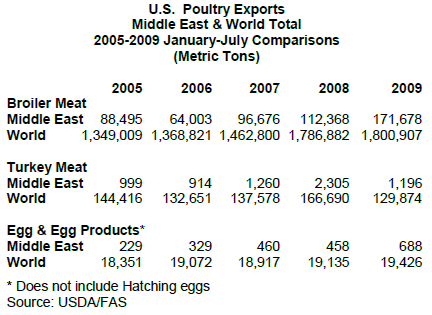



International Egg and Poultry Review
GLOBAL - By the USDA's Agricultural Marketing Service (AMS). This is a weekly report looking at international developments concerning the poultry industry. This week's report focuses on the poultry industry in the Middle East.Poultry imports by Egypt, Saudi Arabia and other countries in the North Africa and Middle East Region now account for about 35 per cent of major trader imports and are projected to rise more than imports into all other countries combined. It is expected economic and population growth will help boost demand and continuing animal disease concerns in some countries in the area expected to hinder growth in domestic production and increased demand for imports.
The United States Department of Agriculture (USDA) Foreign Agriculture Service (FAS) definition of the Middle East includes Bahrain, Gaza Strip, Iran, Israel, West Bank, Iraq, Jordan, Kuwait, Lebanon, Oman, Qatar, Saudi Arabia, Syria, United Arab Emirates, Turkey, Arabian Peninsula States and NEC, Yemen (Aden) and Yemen Sanaa). The states included in the definition of North Africa include Algeria, Egypt, Libya, Morocco and Tunisia.
The Middle East is the main chicken market for Brazilian chicken. From January to August, 2009 Brazil exported 914,000 metric tons of chicken to the region, a 20.6 per cent increase over the same time frame last year. Broiler meat exports from the United States (US), meanwhile, have increased 52.8 per cent to the Middle East for the January-July, 2009 period when compared to last year. US egg and egg product exports also increased 50.2 per cent to the Middle East while turkey meat exports dropped 48.1 per cent when comparing 2008 and 2009 January-July delivery time frames.
For 2010, competition from Brazil into international markets may result in a slight overall broiler export decline for US However, the recent appreciation of the Brazilian real against the US dollar has started creating come concern among Brazilian chicken companies who want to grow exports and their profit margins. The result may help US poultry exports maintain their competitiveness with Brazil into the Middle East and other export destinations.
Sources: USDA/FAS, ThePoultrySite
–Reproduced with Permission




Further Reading
| - | You can view the full report by clicking here. |











